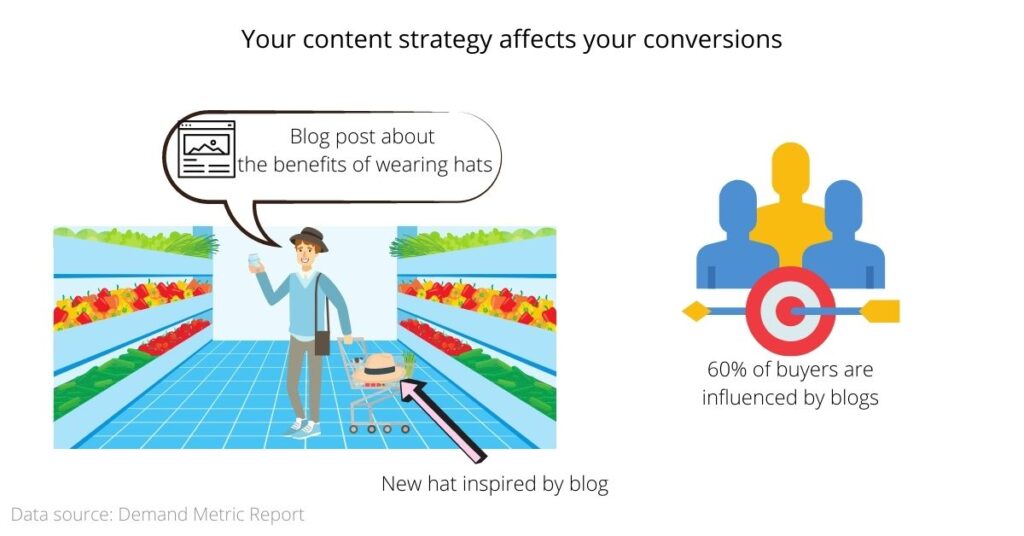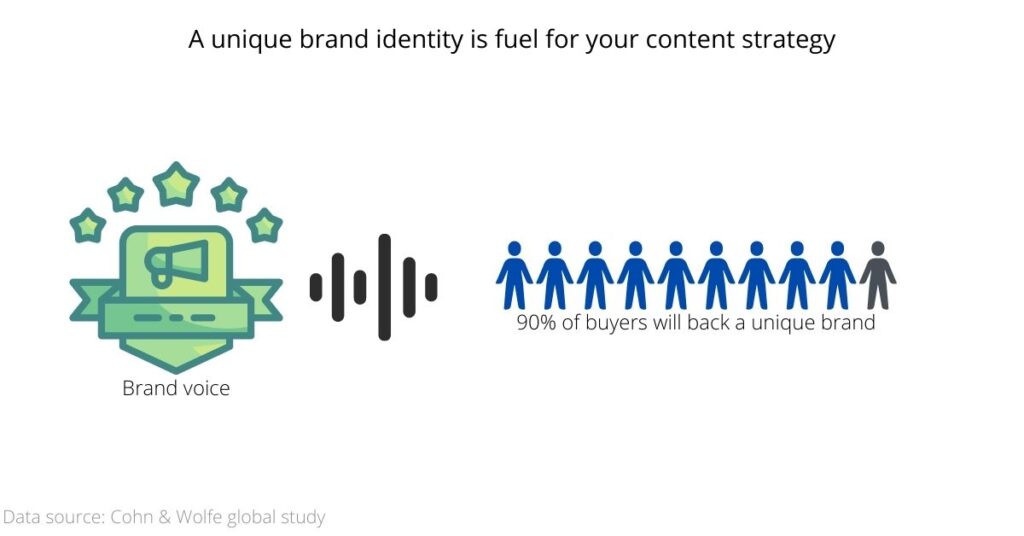Do you have a content strategy for your blog?
A content strategy is like a blueprint for building content. It involves the entire process of planning, creating, and managing content, all the way from establishing your content objectives through to the promotional phase.
Running your small business blog without a content strategy is akin to building a house without a blueprint.
You won’t be quite sure what goes where, and, what, when, and why you need to be doing certain things.
For one, most of your content will be directed at the wrong audience. Additionally, you won’t be able to track content marketing progress and figure out areas to finetune to cut down on costs or boost effectiveness.
Yet, despite these concerns, it remains the fact that approximately 44% of businesses today don’t have a documented content strategy. This is also largely why the same number of businesses feel that their content marketing campaigns aren’t optimal.
In this article, we’ll be discussing how to create a blog content strategy for your small business blog for purposeful content marketing.
Let’s get started:
1. Define Your Content Objectives
What are your content marketing goals?
Content needs to have well-defined objectives, otherwise, you’ll just be producing content for the sake of it. As a result, you won’t have a way to judge how exactly your content is performing because there’s nothing to reference it to.
A study by California’s Dominican university substantiated the importance of goal setting, by establishing that you are 42% more likely to achieve goals if they are documented. This means that it’s not just enough to have content goals mapped out in your mind, it’s important to have documentation backing it up.
So the first step to how to develop a blog content strategy that works is outlining your goals, or what your content aims to achieve.

Perhaps you want to drive more traffic to your website through search engine optimization. If that’s the case, you may find useful this article on SEO best practices for high-ranking small business blogs.
Whatever the end goal is for your content marketing, it should be clear right from the get-go and each article should be building up towards your objectives. If your vision is generating more leads, that should be at the back of your mind.
In addition to content marketing goals being very specific, it’s also vital to have clear KPIs.
For example, if your objective is to increase website retention time, the amount of time users spend on your site over a month of writing content could prove a yardstick of success.
2. Establish Your Target Readers
Who are you writing content for?
If your content is not made with your customers in mind, it’s also likely that your sales conversion is below par.
But don’t just take my word for it.
According to a Demand Metric report, 6 in every 10 buyers say they read a blog post that inspired them to try out a new service or product. That goes to show the power of blogging in driving sales.
Therefore, customers should be your number 1 priority when figuring out how to develop a blog content strategy for a website that’s focused on eCommerce.
For utmost cost-effectiveness, every blog post should be fashioned with a super-specific audience in mind.

Figuring out the buyer persona of your audience is a great way to establish your reader demographic and patterns. By doing so, you can learn how to put customer content needs ahead of what your business believes they need.
So how can you create a buyer persona?
Simply think about the people on the receiving end of your services and ask yourself the following questions:
- What is the average age/gender of your client base?
- What are their hobbies or interests?
- What are their career choices?
For example, if your business offers weight loss solutions, think about people who would be in need of these services and why. That way, you’ll know what topics matter to your readers to help hasten the process across your sales funnel.
3. Build Your Niche and Voice
Now you’ve set your goals, and have a specific buyer persona in mind.
So what next?
It’s time to carve your own unique voice in the market and start churning out some of that content we’ve been talking about.
Like most markets, it’s probably the case that your business has competitors or loads of alternatives online. It’s very easy for your identity to get stuffed out by the crowd.
Authenticity is even more important today, as 9 in 10 buyers are willing to back a brand as long as it seems unique, as reported by a Cohn & Wolfe global study on brand authenticity.
That leads us to building your niche and distinct voice via proper keyword research as the foundation for your content calendar.

We’ll be talking about content calendars in a moment as the next step on how to develop a content strategy that works.
As a small business trying to work your way up search engine results pages (SERPs), you’ll want to use short-tail keywords sparingly. These tend to be highly competitive and typically benefit already well-established blogs.
Instead, long-tail keywords, i.e. entailing at least three words, are the way to go for your small business blog because these are super-specific. As a result, they are used more by your target market.
Some awesome tools you can use to find keyword-based topics include Google Keyword Planner and Ahrefs, to name a few.
4. Create a Content Calendar
With a couple of keyword-researched topics ready, it’s time to draw up a content calendar.
A content calendar puts a time stamp on your projects and keeps tabs on your ongoing tasks.
Without a content guide, you’ll be rushing to generate topics spontaneously, and you won’t have enough time to plan and promote your content.
What’s more, you’ll be speeding through mountains of previous blog posts to figure out what keywords you’ve used each time you want to create a new post.
To avoid that, a content calendar creates a roadmap for your content marketing. It details important information such as team member responsibilities, among other vital accountability details.

While it’s generally recommended to mostly write evergreen topics (i.e. those unaffected by time), your content calendar should also feature seasonal hot topics as well.
What tools do you need to create a content calendar?
There are multiple templates and tools online, however, you can create a content calendar on a basic Excel spreadsheet or the free Google Sheets tool.
The ideal calendar should include:
- Article publishing date and time
- Team member in charge of each post
- Topic and type of content
- Publishing channel.
- Content status i.e. completed, in-progress, or to be done.
Additionally, you can choose to add a section for performance analytics so you can track how your content is performing after publishing.
5. Develop a Promotion Plan
How do you promote your content post-publishing?
If your content marketing simply ends at the publication stage, here is some eye-opening information for you:
Every day, over 7.5 million blog posts are published, according to research by TechJury. Granted those figures decrease depending on exact keywords and niche, the fact still remains that there’s huge competition for traffic.
Therefore, an important step of mastering how to create a blog content strategy entails learning the basics of a content promotion plan.
Just like a content calendar, you can also create a content promotion schedule, highlighting what content you’re promoting, including how, when, and where.

Prioritize high-value, organic promotion channels with paid promotions at the end of your queue.
For example, email broadcasting tends to be more effective than Twitter, offering 6 times higher click-through rates according to a Campaign Monitor market report. Email marketing is therefore effective, so you’ll need to tap into your email list.
Once you have all the channels and resources lined up, be sure to also update your promotion plan with performance analytics as they change.
If you create an article and promote it on social media, for example, a Bitly link offers KPIs such as clickthroughs so you can track performance in real-time.
Whatever tools or channels you use, be sure to create a detailed promotion table including these resources.
Conclusion
Are you happy with your current content strategy?
A poor content strategy will hold you back from fully unlocking the powerful benefits of blogging for your small business blog. If you’d like to find out what those are, be sure to also click on the link above and discover how blogging can grow your business.
Learning how to create a content strategy for a website is one thing, however, keeping up the same efforts months into the project can be difficult for small businesses. It takes up a lot of time and manpower, which you may not have to spare in these resource-strapped times.
Alternatively, it seems like you’re doing everything right, yet your content marketing is just not coming off for you. Website traffic has stagnated, lead generation has dipped, and you’re nowhere near where you want your business to be in terms of SEO.
If that describes you, reach out to us here.
Our content marketing and industry experts will help you develop and maintain a content strategy that works for your small business.





